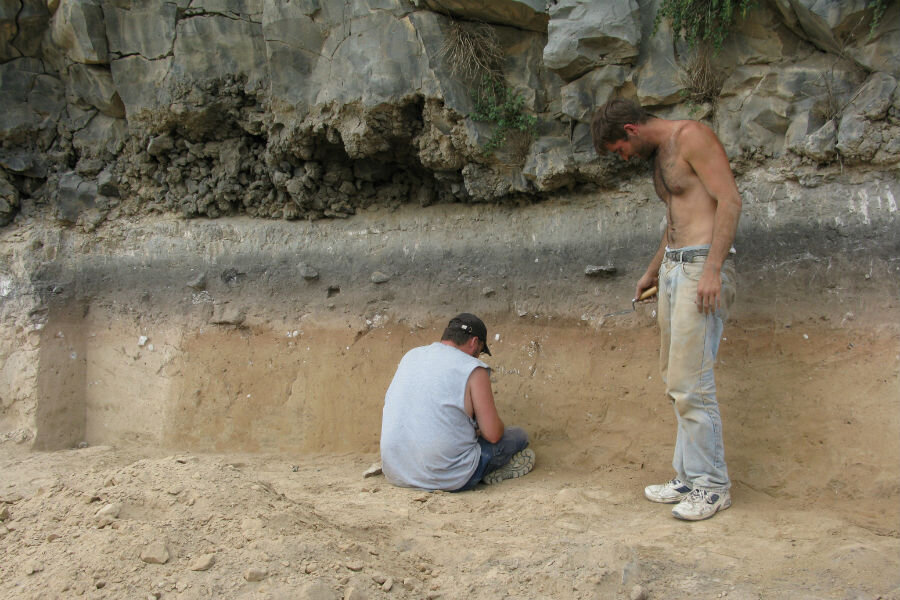Precision toolmaking arrived independently in Eurasia and Africa, say scientists
Loading...
If our species could be famous for just one thing, a strong candidate would be our tendency to use tools to manipulate our environment. But excavation of a newly discovered archeological site in the Southern Caucus suggests that Homo sapiens were not the only ancient hominids to create precision tools.
New analysis of more than 3,000 artifacts recovered from the 325,000-year-old Nori Geghi 1 archeological site in Armenia has turned one prominent theory about the development of stone toolmaking processes on its head.
The archeological record shows that many branches of early hominids used a bifacial stone toolmaking techniques to create somewhat clunky tools such as hand-axes. Bifacial technology, likely developed 1.75 million years ago, involves shaping one stone, known as a core, by striking it with another stone. As hunter-gatherers hammered the core into shape, chips and flakes of various sizes fell away and were typically discarded as waste.
At some point, toolmakers began to see the flakes themselves as useful tools. Using a process, which archaeologists have dubbed the Levallois technique, hunter-gatherers began to focus on the core as a source of flakes rather than the end product. The Levallois flakes were lighter and more precise than the chunky biface tools, making them ideal for cutting, skinning, and scraping.
This shift from biface to Levallois technology is considered the hinge point for the Early Stone Age and Middle Stone Age. The prevailing theory suggested that this transition occurred in Africa and that H. sapiens exported the Levallois technique from Africa to Eurasia.
But recent excavations at Nori Geghi 1 uncovered Levallois tools dating back long before H. sapiens migrated into Eurasia. This suggests that the technique evolved independently in both Africa and Eurasia, says paleoanthropologist Daniel Adler, an anthropology professor at the University of Connecticut in Storrs, Conn., and lead researcher on the Nori Geghi 1 dig.
Professor Adler can’t say for certain which hominid species crafted the tools at Nori Geghi 1, because the fossil record for this time period is not yet complete.
“This time period is very murky in terms of evolution and who’s making what,” Professor Adler says. “While there are a lot artifacts, there aren’t that many fossils around, and most of them aren’t not dated particularly well.”
One possibility is that the manufacturers were Homo heidelbergensis, a shared ancestor of H. sapiens and Neanderthals.
Anthropologists believe that H. heidelbergensis lived about 500,000 years ago; that those living in Europe are thought to have evolved into Neanderthals while those living in Africa evolved into H. sapiens. But the precise evolutionary pathways remain murky, which means that the toolmakers at Nori Geghi 1 could also have been some transitional species somewhere between H. heidelbergensis and Neanderthals.
Gaps in the archeological record are particularly pronounced in Europe, where erosion frequently caused various layers of earth to mix in ways that make it difficult to date fossils and artifacts, Adler explains.
Nevertheless, Adler and his team have been able to date the artifacts found at Nori Geghi 1 with a surprising degree of precision.
Nori Geghi 1 is situated along the a gorge carved by the Hrazdan River, which cut through basaltic lava flows from volcanoes in the western part of the Gegham range.
“What’s nice about this site is that it is capped by lava which we can date [to 197,000-years-old], it’s underlain by a lava that we can date [to 441,000-years-old], and there’s volcanic ash that we can date [to 308,000-years-old], so we have a lovely dating package,” Adler explains.
Adler was able to pinpoint those dates within a margin of error of just 7,000 years, a level of precision that is almost unheard of for this time period, says Harvard anthropologist Christian Tryon, who was not involved in the Nori Geghi 1 excavation.
“The most striking thing about [Adler’s research] … is that the quality of the excavation and the quality of the dating of the site is some of the best that I have seen in a decade,” Professor Tryon says. “For those of us that work in deep time … 10,000 years is considered a tight and narrow age range.”
In his own work in Africa, Tryon often has to rely on a window of up to 300,000 years when dating artifacts and fossils.
This time capsule that has been trapped between those two lava flows for thousands of years has also yielded some information about how hunter-gatherers might have viewed the two technologies.
Some anthropologists have categorized Levallois technology as more complex than the biface technique. But Adler found both biface and Levallois tools side by side within the same layers of earth, suggesting that whoever these toolmakers were, they seem to have used both techniques simultaneously.
“I wouldn’t consider this some sort of superior technology and the biface as being primitive,” Adler says. “What I think it reflects is a new way for people to solve the same old problem of how do you get your food and make your way in the world.”
Adler's findings were published in the Sept. 26 issue of Science.






